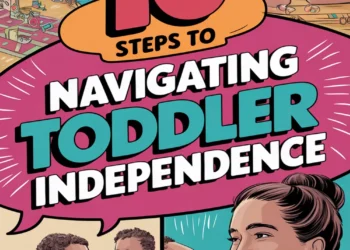To reduce toddler tantrums, start by understanding their emotions and acknowledging their feelings. Establish a consistent routine that offers security, and set clear, simple expectations to guide their behavior. Encourage open communication by using simple language and actively listening. Create a calm environment to minimize overstimulation. By offering choices, you foster independence, while positive reinforcement builds good behavior. Remember, your patience and self-care are key, and there’s much more to explore for lasting solutions.
Understand Your Toddler’s Emotions
When your toddler throws a tantrum, it often stems from overwhelming emotions they can’t fully express. They may feel frustrated, anxious, or even tired, but lack the words to convey these feelings. Acknowledge their emotions by validating them—you might say, “I see you’re upset.” This reassures them that it’s okay to feel what they’re feeling. Watch for signs of distress; a furrowed brow or clenched fists can indicate they’re struggling. Respond with calmness and patience, offering them choices to regain a sense of control. For example, suggest picking a toy or snack. By understanding their emotional landscape, you not only help them work through their feelings but also build a foundation for better communication in the future.
Establish a Consistent Routine
Establishing a consistent routine can greatly ease your toddler’s emotional turmoil. When they know what to expect, it provides a sense of security. You can create a daily schedule that includes meals, playtime, and bedtime. This predictability can help reduce tantrums and anxiety.
| Routine Part | Emotional Impact |
|---|---|
| Morning Wake-Up | Starts the day with comfort |
| Meal Times | Encourages calmness |
| Bedtime | Promotes a sense of safety |
Listen to their needs throughout the day. If you notice signs of frustration, revisit your schedule. Routines not only help your toddler feel secure; they also create a smoother day for you both. You’ll notice the difference!
Recommended Items
Explore these helpful products and tools to make parenting a little easier and keep those toddler tantrums at bay!
Products
Set Clear and Simple Expectations
Setting clear and simple expectations can dramatically improve your toddler’s behavior and reduce tantrums. When you clearly communicate what you expect, your child knows what’s on the horizon, which helps them feel secure. Keep your instructions straightforward and age-appropriate; for instance, say “It’s time to clean up your toys” instead of vague direction. You might also find it helpful to set a limit on choices—like, “You can wear the red shirt or the blue one.” This gives your child a sense of control while keeping things manageable. Remember, consistency is key. Repeating the same expectations helps reinforce understanding and decreases frustration for both of you. With a little practice, you’ll create a smoother environment that fosters positive behavior.
Step-by-Step Guide to Taming Tantrums
Encourage Open Communication
While it might feel challenging at times, encouraging open communication with your toddler can greatly reduce the frequency of tantrums. When your child feels heard and understood, they’re less likely to resort to outbursts. Here are a few practical ways to foster that dialogue:
- Use simple language: Keep your sentences short and clear to make it easier for them to express themselves.
- Ask open-ended questions: Instead of yes or no questions, try asking “How do you feel about that?” to prompt deeper conversations.
- Listen actively: Show you’ve listened by repeating back what they say. This makes them feel valued.
Create a Calm Environment
Creating a calm environment at home can greatly help in reducing toddler tantrums. When you foster tranquility, your little one feels safe and secure. Simple changes like decluttering, using soft lighting, and incorporating soothing colors can make a difference.
Here’s a quick reference to create that atmosphere:
| Element | Suggestions |
|---|---|
| Space | Declutter toys and distractions |
| Lighting | Use soft lamps or natural light |
| Color | Opt for soothing shades like blues or greens |
Take a moment to observe your space. By minimizing overstimulation, you’re promoting a sense of peace, making it easier for your child to express themselves without frustration. Feel free to experiment and find what works best for your home!
Offer Choices to Foster Independence
Offering choices to your toddler can greatly enhance their sense of independence and reduce tantrums. When kids feel they have some control over their daily activities, they’re less likely to feel frustrated. You don’t need to present overwhelming options; just a few can make a big difference.
Consider these simple choices:
- “Would you like to wear the red shirt or the blue one?”
- “Do you want to read a book or play with blocks?”
- “Would you prefer apple slices or carrot sticks for snack?”
These options allow your toddler to voice their preferences, promoting confidence and decreasing resistance. Remember, it’s all about giving them a sense of agency in a world where they often have little control.
Use Positive Reinforcement
Using positive reinforcement can transform your toddler’s behavior and markedly reduce the frequency of tantrums. Instead of focusing on negative behaviors, celebrate the good moments. When your little one shares, listens, or follows instructions, acknowledge their efforts with praise or small rewards. This encourages them to repeat those positive actions.
Make your praise specific—rather than a general “good job,” try saying, “I’m so proud of you for sharing your toys!” Consistency is key; regularly reinforcing desired behaviors establishes a clear connection between their actions and positive outcomes. Over time, this method nurtures a supportive environment where your toddler feels valued, leading to fewer outbursts. Approach each situation with love and understanding, and watch as their confidence grows!
Practice Patience and Self-Care
While it might be challenging to remain calm during your toddler’s tantrums, practicing patience and self-care is essential for both you and your little one. When you’re more grounded, you’ll navigate their emotions more effectively. Here are a few helpful tips to take into account:
- Take breaks: Stepping away for a moment can help you recharge. A deep breath or a quick walk can work wonders.
- Find support: Connecting with other parents can provide comfort and new strategies. Sharing experiences is invaluable.
- Prioritize self-care: Make time for activities you enjoy, whether it’s reading, exercising, or having coffee with a friend.













